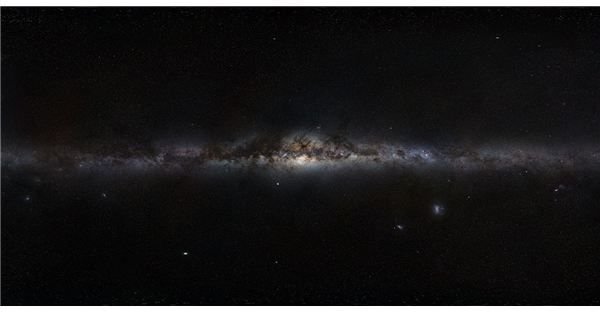The Milky Way: What is It? What Is It Made of?
What is the Milky Way?
Simply put, the Milky Way is a galaxy—more specifically, a spiral galaxy. (Galaxies take on different shapes, and can be spiral, barred, elliptical or irregular.) It may be a barred spiral galaxy. It is part of a set of galaxies termed the Local Group. On a clear, dark night, what appears like fine gauze (Isaiah 40:22) is draped over the night sky. This gauze is a portion of the Milky Way, our celestial home.
The Milky Way consists of arms spiraling outward from a brilliant glowing center. The Sun revolves around the outer edge of the Milky Way, traveling at half-a-million miles-per-hour, situated approximately 26,000 light-years from the galaxy’s center. Astronomers estimate that the Milky Way contains perhaps 400 billion stars and is more than 100,000 light-years across. If this seems like a lot of stars, consider our neighbor, the Andromeda galaxy—another spiral galaxy. It is estimated to contain a trillion stars!
The term “Milky Way” is derived from the Ancients who thought the streak of white across the heavens looked like a river of milk. Stars, planets, gas clouds, clusters and nebulae make up our galactic home. Surrounding the Milky Way is a “halo.” The halo is a roughly spherical distribution of older stars, surrounding the galaxy. The Milky Way is believed to contain a black hole called Sagitarrius A*, or Sag A*. One recent discovery is the existence of two “bubbles” of energy containing an energy equivalent to 100,000 supernova explosions.
Planet Earth’s Location Inside the Milky Way
Earth (and the rest of our Solar System) is located at the outer edge of the Milky Way in an area called the Orion arm. In particular, our Earth may lie inside a small portion of the Orion arm called the Gould belt, an elliptical area of hydrogen clouds and young stars. Earth thus orbits the center of our Milky Way galaxy. It completes one orbit in an estimated 200 to 250 million years.
According to a current theory of the universe, ninety percent of galaxies are made up of dark matter. In fact, the Milky Way Galaxy’s halo is not luminous; its identity as dark matter has been inferred from a perceived gravitational pull on its visible matter. Some astronomers believe the Milky Way is increasing in size by “swallowing” stars and scattered clouds of dust. These are thought to be derived from older galaxies. The universe maintains its own recycling center.
How the Milky Way Compares
So how does the Milky Way compare with other galaxies? Hubblesite affords many photographs of various galaxies. Much as our Sun compares to that of other stars, the Milky Way is nothing outstandingly spectacular. It is one of literally billions of galaxies. There are those larger and those smaller.
Some outstanding examples, worthy of consideration, include the Cigar Galaxy, M82; the Sombrero Galaxy, M104; and the nearby spiral galaxy M81. One very special situation involves two colliding galaxies! They are NGC6050 and IC1179, found in the Hercules cluster of galaxies. The Hercules Galaxy Cluster is part of the Great Wall of clusters and superclusters which constitutes the largest known structure in the universe.
So is the Milky Way Galaxy something ordinary then? Not at all. It is beautiful; it is the only galaxy proven to contain life; it’s home sweet home!
References and Resources
Image: Milky Way Galaxy - Panoramic View: Credit: ESO/S. Brunier
Students for the Exploration and Development of Space (SEDS): The Milky Way Galaxy
New Scientist: Andromeda galaxy hosts a trillion stars
University of California - San Diego: The Milky Way Galaxy
NASA: The Orion Arm: Video - From Earth to Outside the Milky Way Galaxy
Also from Bright Hub: Guide to the Milky Way Galaxy
